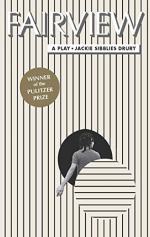|
This section contains 702 words (approx. 2 pages at 400 words per page) |

|
Fairview Summary & Study Guide Description
Fairview Summary & Study Guide includes comprehensive information and analysis to help you understand the book. This study guide contains the following sections:
This detailed literature summary also contains Quotes and a Free Quiz on Fairview by Jackie Sibblies Drury.
The following version of this play was used to create this study guide: Sibblies Drury, Jackie. “Fairview.” Theatre Communications Group, Inc. New York, NY, 2019. First Edition. The play dramatizes long-standing racial tensions in the United States, blending a number of different realities in a highly theatrical way.
In Act One, perfectionist Beverly, a black woman who appears to live in an upper-middle class home, anxiously prepares a birthday celebration for her mother. She is joined by the other black members of her family: her playful, affectionate husband Dayton; her comically assertive sister Jasmine; and her college-bound daughter Keisha. There is a phone call from Beverly’s brother Tyrone, who says he is unable to attend the birthday party, and references to Keisha’s best friend Erika. As preparations and family conflicts intensify, Beverly becomes more and more upset, but she eventually joins in a dance with the rest of the family. After the dance, Beverly again resumes her preparations, becoming upset when she learns that the birthday cake has burned. Suddenly, she collapses in a faint.
Act Two then begins with the same images and actions as Act One. As the black characters replay their physical actions from Act One, two white people have a conversation in which they discuss which race they would be if they were not white. The conversation is initiated by Jimbo, who says he would be Asian. Jimbo's attitudes and choices are challenged by an older woman named Suze. When another young man, Mack, says he would opt to be Latino, Suze also challenges him. Jasmine makes her first appearance at the same time as Mack. Finally, as Keisha makes her entrance, a fourth white character appears: an older woman of European origin named Bets, who comments on how the question of race is a uniquely American preoccupation, but who then says if she could, she would choose to be Slavic. As the action of the black family continues, Suze says that if she had the choice, she would choose to be African-American, explaining that she feels empathy for persons of that race because she was raised by a black woman.
Arguments between the white characters reach a point of confrontation even as the celebrations of the black characters turn into their dance. At a climactic point in both, Beverly faints. Conversation between the white characters continues as new action continues for the black characters, actions that are described after the dialogue for the white characters. Essentially, the black characters help Beverly recover from her collapse and finish preparing the family dinner table for the party, bringing in increasingly unusual-looking food and dancing in increasingly unusual ways even as Jimbo erupts into an extended rant about a movie that he would love to make, a movie in which he has the power to control the story being told and is also its villain. As the speech and the dance both conclude, the white characters disappear.
Act Three begins with Beverly calling upstairs to her mother, who makes a glamorous appearance in clothes that had been previously described. She is played by the white woman who played Suze. As she joins the party, Keisha starts to feel uncomfortable. As the party continues, Jimbo appears, dressed in his idea of what Tyrone would look like. As he too joins the party, Keisha feels more uncomfortable, a dis-ease that increases even more when Mack appears, dressed in drag and pretending to be Erika. Finally, Bets appears, presenting herself as a jazzier version of the grandmother. Keisha becomes increasingly upset as the white/black characters bring news of family misfortune.
With the well-meaning but unconsciously racist encouragement of her Suze-grandmother, Keisha speaks her mind, eventually turning to the audience and asking whether it is possible for some of the white people there to join the characters on stage. She goes on to speak of how important it is for black people to tell their stories on their own terms, and for white people to hear those stories openly and honestly. She ends her long speech, and the play, with a plea for everyone to look at each other, see each other, and treat each other with fairness.
Read more from the Study Guide
|
This section contains 702 words (approx. 2 pages at 400 words per page) |

|



